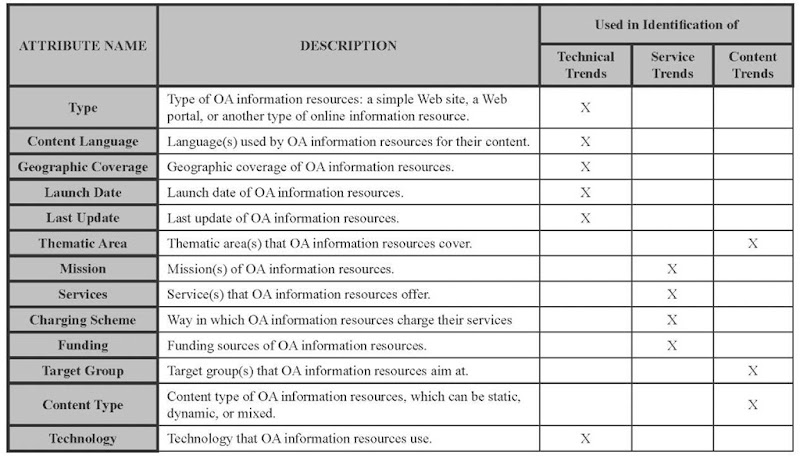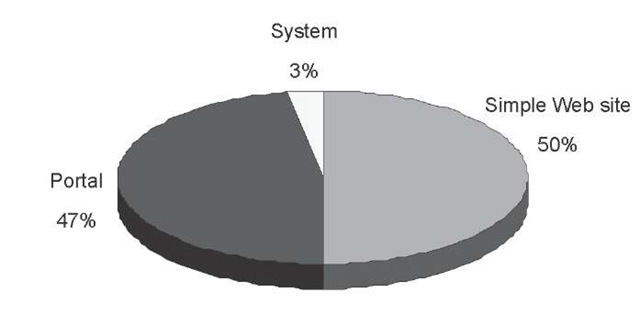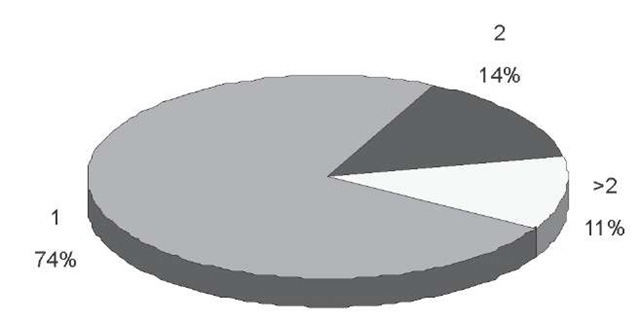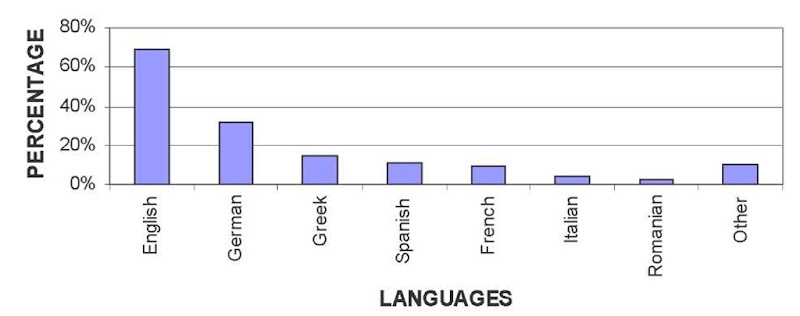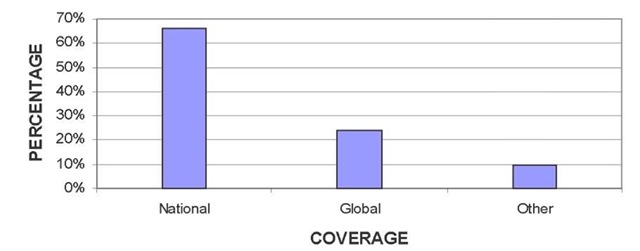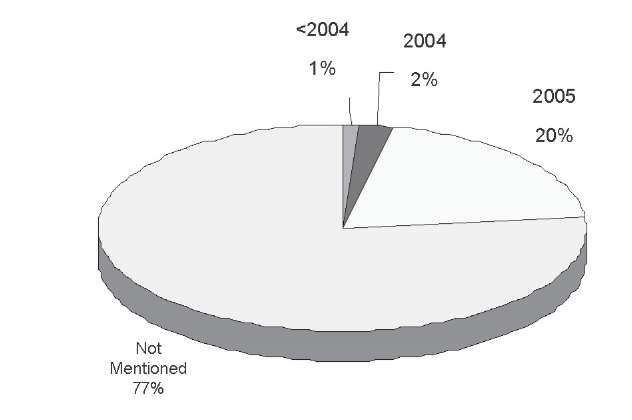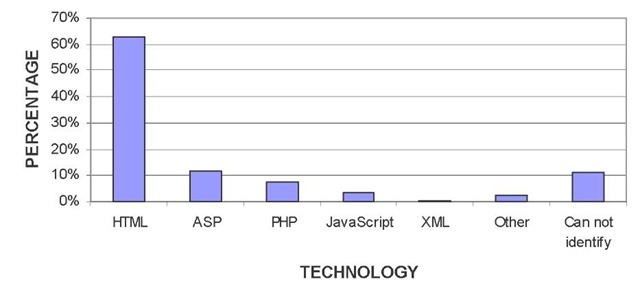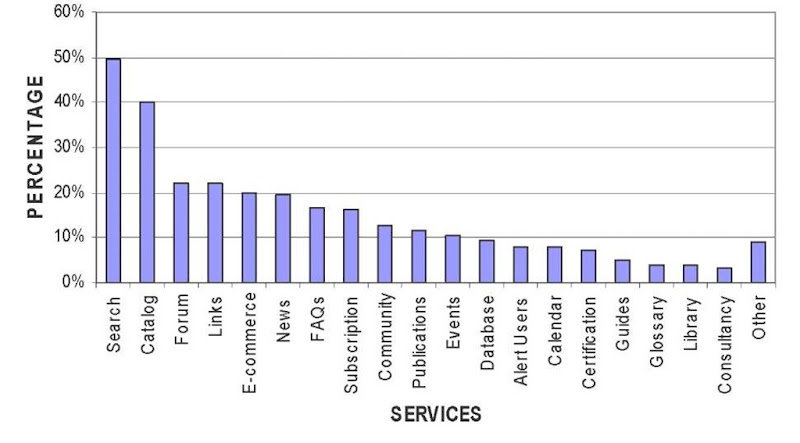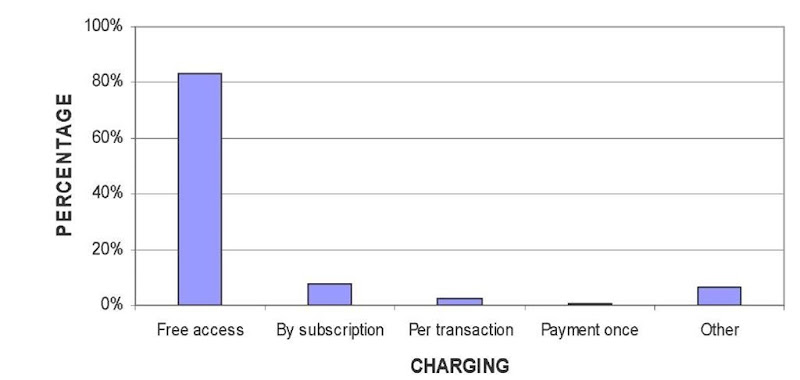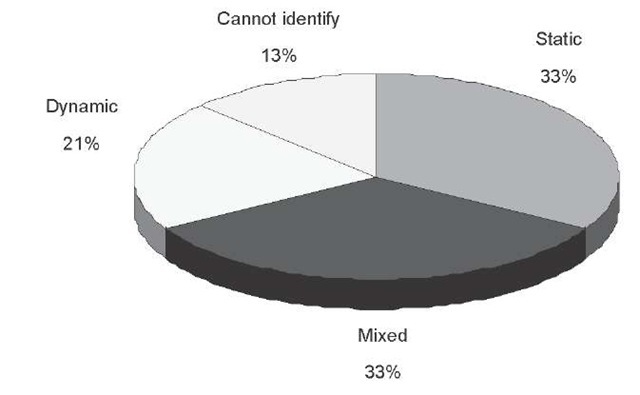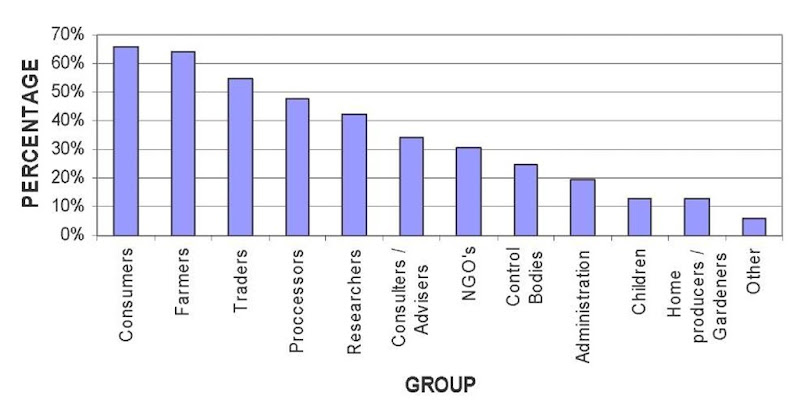INTRODUCTION
According to the Food and Agriculture Organisation of the United Nations (FAO, 2005), organic agriculture (OA) is “a holistic production management system which promotes and enhances agro-ecosystem health, including biodiversity, biological cycles, and soil biological activity.” In recent years, the rapid evolution of the Internet has given the opportunity to create a large number of Web sites, Web portals, and other information resources concerning OA (for the remainder of this article, we will refer to them as OA information resources). The ultimate goal behind these attempts has been the dissemination of information to farmers, traders, agriculturists, consumers, and even children, and the provision of specialised services on OA. This has lead to a plethora of Web-based information systems and inevitably, has created the need for a detailed analysis on the positioning of a new Web portal regarding OA before proceeding to design and implementation. Dibb et al. (Dibb, Simkin, Pride, & Ferrel, 2007) define positioning as “the process of creating an image for a product in the minds of target customers.”
To identify, as realistically as possible, the structure and content of a new OA portal that will cover the needs of OA actors (as these will be described later in the article), the current situation of the existing online OA information resources (such as portals, Web sites, Internet resources, SMS, and e-services) should be examined first (Sideridis, Patrikakis, & Manouselis, 2005a). This article presents the results from the analysis of 180 OA information resources. This analysis allowed identifying the main trends in related competition and positioning a new OA portal named “Bio@ gro” (Sideridis, Costopoulou, Patirkakis, Manouselis, & Stalides, 2005b) among these dimensions.
ORGANIC AGRICULTURE ACTORS AND THEIR NEEDS
In order to have a clear view of the European OA value chain, it is necessary to distinguish its actors, their roles, and needs.
These are the following (Costopoulou, Karetsos, Ntaliani, Gidarakou, & Sideridis, 2004):
• Organic farmers (individuals or groups of farmers), who produce organic products and are interested in selling them and buying plant-breeding material and seeds
• Traders, who buy and distribute organic products
• Processing companies, which purchase organic products and use it as raw material for the production of secondary products
• Consumers/citizens, who want to be informed about, or buy, organic products
• National governmental organisations and agencies (e.g., Ministries of Agriculture), which are responsible for the provision of all the necessary legislation and support, and the coordination of developing initiatives
• Organizations for the certification and supervision of agricultural products, which are the pertinent bodies for the evaluation and supervision of the certification organizations, the allowance of the national certification sign for organic products and the control of their trading
• Certification and inspection organizations, which are the exclusive certification bodies for organic farmers
• Research institutions and universities, which are in charge of the research for technological improvement and development of the OA sector
• Agronomists, farm advisors, and consulting firms, who inform other OA actors, such as organic farmers
• European Union (EU) agricultural agencies, which are responsible for OA activities in Europe
In order to analyse the level of OA information that these actors have access to online, we performed a survey on the current situation of OA information resources. The goal of this survey has been to outline the current status of OA-related information in the Internet.
METHODOLOGY OF THE SURVEY
In order to identify the market trends and needs, and to help positioning the new Web portal in the vast amount of relevant competition (Tatnall, 2005), a survey based on a large sample of worldwide available OA information resources has been conducted. To identify main trends in OA information sources, a collection of information resources’ attributes has been created, according to the relevant literature (e.g., Barnard, 2001; Large, Beheshti, & Cole, 2002; Morville & Rosenfeld, 2002; Preece, Rogers, & Share, 2002; Sampson & Manouselis, 2005). The list of attributes examined for OA information resources is presented in Table 1.
In order to identify OA information resources, various Internet search engines were used, with Google (http://www. google.com) and Yahoo (http://www.yahoo.com) as the main
ones. After a detailed search, 180 OA information resources from different countries and in different languages have been collected. It has to be mentioned that due to linguistic obstacles (e.g., for sources in the Chinese language), our survey sample mainly consisted of European, USA, Canadian, and Australian OA links. A complete listing of the Web sites evaluated can be found in “Bio@gro market survey and positioning” (Bio@gro, 2005).
In the context of the survey, a multilingual team (consisting of Greek, German, Romanian, and Cypriot experts) took over the analysis of the collected sample, upon the aforementioned attributes for each of the 180 OA information resources. The acquired information was processed with the use of SPSS statistical package (http://www.spss.com).
survey Results
In the following paragraphs, the results of the survey upon each of the examined attributes are presented.
Technical Trends
Type
The collected resources have been classified in the following categories (based on the definitions of Webopedia, http://www.webopedia.com):
Table 1. Attributes used for OA information resources analysis
Figure 1. Technology of OA information resources
Figure 2. Number of content languages on OA information resources
Figure 3. Content languages of OA information resources
• Simple Web Site: A site (location) on the World Wide Web. Each Web site contains a home page, which is the first document users see when they enter the site. The site might also contain additional documents and files. Each site is owned and managed by an individual, company, or organization.
• Web Portal: A Web site or service that offers a broad array of resources and services, such as e-mail, forums, search engines, and online shopping malls. The first Web portals were online services that provided access to the Web, but by now most of the traditional search engines have transformed themselves into Web portals to attract and keep a larger audience.
• Online Information Resource: Any other type of online information content source or content management system that collects and stores data online.
As depicted in Figure 1, half of the OA information resources (50%) may be classified as simple Web sites, while 47.2% as Web portals. A very small percentage are other types of information resources (2.8%).
Content Language
Regarding the content language used, the survey revealed that most of the OA information resources (73.9%) present their content in one language, while only a small percentage (14.4%) in two or more than two (11.7%). As for the most popular content language among OA information resources, this is English with a percentage of 68.9%, followed by all the other languages. This was expected, since most of the OA information resources use the English language besides their native language, in order to promote their content to more users. Figure 2 and Figure 3 present these results.
Geographical Coverage
Regarding the geographic coverage, this varies from national level to international or even global level. As it can be seen in Figure 4, the majority of the OA information resources (66.1%) aim at a national coverage, in contrast with those that aim at a global level (23.9%).
Figure 4. Geographic coverage of OA information resources
Figure 5. Launch date of OA information resources
Figure 6. Last modification of OA information resources
Launch Date
Based on the launch date of OA information resources, we can draw conclusions regarding the period that OA was introduced in the Internet. Unfortunately, as Figure 5 clearly indicates, a large percentage of OA information resources (75.6%) do not include any information about their launch date. The only conclusion we can safely report is that a percentage of 8.3% first appeared in the period 1995-1999, while 16.1% in the period 2000-2005.
Last Modified
It should be noted that an important attribute is the date of the last update of OA information resources. This attribute indicates if an online OA source is active and what is its update frequency. According to the results of our survey, only 23% of the OA information resources examined included information regarding their last update, and of these most were updated during 2005. The following graph presents these results in the form of a pie chart.
Technology
The technology used is defined in terms of programming languages used, and has been identified as varying mainly between:
• HTML (Hyper Text Markup Language)
• ASP (Active Server Pages)
• PHP (Hypertext Preprocessor)
• JavaScript
• XML (Extensible Markup Language)
As it is depicted in Figure 7, the technology used in most of the OA information resources was HTML (62.8%), while 11.7% used ASP, 7.8% PHP, 3.3% JavaScript, and less than 1% XML. On 11.1% of the OA information resources studied, the technology used was not reported or could not be identified.
Figure 7. Technology of OA information resources
Figure 8. Mission of OA information resources
Service Trends
Mission
According to our analysis:
• 81.1% are designed for informative purposes (i.e., what is OA, what are OA principles).
• 55.6% serve as education tools (i.e., how to apply OA, Best Practice Guides)
• 41.1% of OA Web sites serve as business-commerce (e-business, e-commerce) promoters about OA products and services.
• 21.1% give information or links to government standards, services, and institutions related to OA, while
• 20% include OA legislation and standards in their main page.
• Less than 20% (17.2%) of studied OA Web sites, portals, and information systems serve as online market for OA products and services.
• 10% of OAWeb sites, portals, and information systems are involved in OA certification affairs (i.e., certification bodies, certification documents, and product labeling.).
• And 20% of OA information resources set as their mission: job opportunities on OA, research on OA, and other related services.
A graphical representation of the results is given in Figure 8. Consequently, rendering of OA information, education, and e-business/e-commerce on OA products and services are defined as the main mission of existing OA information resources, in response to the major needs of OA sector.
Table 2. Description of the services provided by OA information resources
|
SERVICE |
DESCRIPTION |
|
Alert Users |
Alerts users for forthcoming disasters. |
|
Calendar |
Marks and prompts of important OA dates. |
|
Catalog |
Presentation of the source’s content in a form of indexed list. |
|
Certification |
Instructions about how to certify OA products. |
|
Community |
The ability to create a network of ties that provide sociability, support, communication, identification, collaboration, around a common idea (Axup, 2005). |
|
Consultancy |
Advice for subjects concerning OA. |
|
Database |
Opportunity to search OA database. |
|
E-commerce |
Promotes OA e-commerce. |
|
Events |
Informs users about OA events. |
|
Forum |
Opportunity to participate in a forum. |
|
FAQs |
Display of frequently asked questions along with their answers. |
|
Glossary |
Listing, presentation, and explanation of OA related terms. |
|
Guides |
Directions and guidelines about OA. |
|
Library |
Display of the content of OA site or portal in a library format. |
|
Links |
Display of a list with OA related links. |
|
News |
Informs users about anything new in OA field. |
|
Publications |
Opportunity for users to find publications concerning OA. |
|
Search |
Opportunity to search through the site or portal for desirable information. |
|
Subscription |
Opportunity to subscribe in order to receive news and information about OA. |
Figure 9. Services of OA information resources
Figure 10. Charging scheme of OA information resources
Services
The offered services by OA information resources are summarized in Table 2.
As it is illustrated in Figure 9, about half of the OA information resources offer search and catalog services (49.4% and 40% respectively), while a considerable percentage offer a forum (22.2%), links (22.2%), e-commerce (22.2%) and news (19.4%). On the contrary, glossary (3.9%), library (3.9%), and consulting (3.3%) are services that are not well supported .
Charging Scheme
The majority of OA information resources (83.3%) offer free access (Figure 10), while only 7.8% are accessible to users through subscription. Only 2.2% of the OA information resources charge their users per transaction and less than 1% apply the method of “pay once” (charging the user once and then allowing him free future access), while other methods of charging correspond to approximately 6% of OA information resources (6.1%).
Funding
Web portals are usually dynamic sources of information, and require funding in order to maintain their viability. Although in most examined cases (18.9%) funding source is not mentioned, advertising proves to be the main one (23.3%), while e-commerce services (selling OA products online) seems to contribute 16.1% to funding of existing OA information resources. Other funding sources, such as community sponsorship, donations, subscription, and membership, seem to be very limited in OA information resources. The results of the survey as regards funding methods are summarized in the Figure 11.
Content Trends
Thematic Area
At this point, it should be mentioned that in our survey, the sample covered more areas of agriculture and environment than only OA. Table 3 lists the covered thematic areas.
Most OA information resources, besides their focus on OA topics, cover environmental (36.7%), ecology (30.6%), and general agriculture issues (25.6% crops and 25% animals). On the other hand, only 6.7% of our sample demonstrate interest in the field of agrotourism and organic holidays, and 5.6% for lifestyle. Figure 12 summarizes these results.
Content Type
Regarding the diachronic nature of the content, we can distinguish the following categories:
• Static: By the term static, we define content that has been produced once and is not updated, or the update frequency is so low that it can be considered insignificant.
• Dynamic: By the term dynamic, we define content that is constantly updated either to reflect latest developments, or report news.
• Mixed: This is the case where content is of both of these forms.
From the 180 cases studied, 33.3% proved to have static content, and only 20.6% contained dynamic material that was transformed and enriched with new OA reports, legislation changes, and OA research developments. Thirty three and one third percent of OA information resources seemed to have a mixed content, combining the static and dynamic type, and for 12.8%, it was impossible to characterise content using any of these content types. Figure 13 demonstrates these results.
Figure 11. Technology of OA information resources
Table 3. Description of OA information resources
|
THEMATIC AREA |
DESCRIPTION |
|
Agriculture animals |
General agriculture animals’ issues. |
|
Agriculture crops |
General agriculture crops issues. |
|
Agrotourism/Organic holidays |
Agrotourism and organic holiday issues. |
|
Ecology |
General ecological issues. |
|
Environment |
General environmental issues. |
|
Food and diet |
Food and diet issues. |
|
Gardening |
Gardening issues. |
|
Lifestyle |
Lifestyle issues regarding OA. |
|
OA animals |
OA animal issues. |
|
OA crops |
OA crop issues. |
|
Organic home producers |
Organic home producers’ issues. |
|
Organic products |
OA product issues. |
Target Group
OA information resources aim at various and usually multiple target groups. As it can be seen in Figure 14, the most popular target groups are consumers (66.1%), farmers (63.9%), and traders (55%). A significant percentage of OA information resources aims at processors (47.8%), researchers (42.2%), and consultants/advisers (33.9%). On the other hand, a very small percentage is interested in children (12.8%) and home producers/gardeners (12.8%).
Figure 12. Thematic area of OA information resources
Figure 13. Content type of OA information resources
Figure 14. Target groups of OA information resources
CONCLUSION
In this article, we have presented an analysis of existing competition of OA information resources. This analysis has produced several valuable results that have helped us in deciding upon the positioning of the Bio@gro portal. More specifically, it has been demonstrated that the majority of OA information resources have been classified as being simple Web sites or Web portals, and are freely available to the public. Most of them use English as the main content language, and have global (international) coverage. The prevailing technology used is HTML. Almost all of the OA information resources are designed for providing information concerning OA. About half of them offer search services. The thematic area of most of these resources focuses on OA crops and animals. Finally, the most popular target groups seem to be consumers and farmers.
The methodology followed through this study can serve as an initial road map for performing a survey with wider coverage. Our survey focused mainly on Europe and North America. The next step towards a comprehensive global survey would be to perform a complementary survey in countries from Asia, South America, and Africa, and to compare/combine the results. The results presented in this article may also serve as the starting point for positioning other types of OA Web portals. For example, the data collected may be reanalyzed, focusing on the OA resources that aim at a particular target audience. We aim to perform a post-analysis of the results, in order to focus on the target group of end-consumers, as well as to identify the major trends in educational OA resources. In this way, it will become possible to design and develop Web portal services that will specifically aim at the education of the end-consumer (including children) about the benefits of OA products.
KEY TERMS
Active Server Pages (ASP): Dynamic Web pages created through the use of ActiveX scripting.
extensible Markup Language (XML): A W3C-recom-mended general-purpose markup language for supporting data sharing across different systems over the Internet.
HyperText Markup Language (HTML): A scripting language used to create documents on the World Wide Web.
Hypertext Preprocessor (PHP): An open-source programming language for developing server-side applications and dynamic Web content.
JavaScript: A scripting language developed by Netscape to support interactive Web site creation.
OAActors: All categories of individuals, organizations, companies, research, and educational institutions, national and European organizations and agencies, as well as any other actor interested or involved in the area of organic agriculture.
Organic Agriculture: Holistic production management systems that promotes and enhances agroecosystem health, including biodiversity, biological cycles, and soil biological activity.
